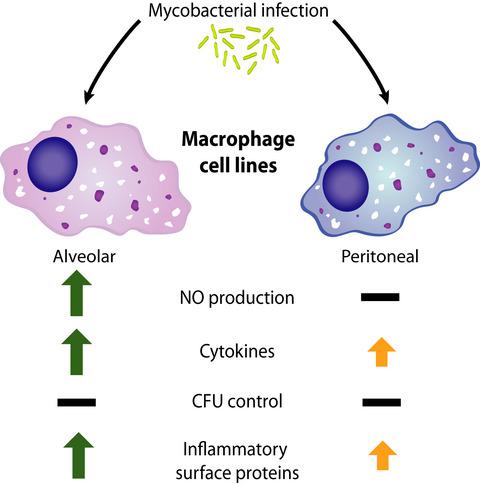当前位置:
X-MOL 学术
›
Immunol. Cell Biol.
›
论文详情
Our official English website, www.x-mol.net, welcomes your
feedback! (Note: you will need to create a separate account there.)
Macrophages of different tissue origin exhibit distinct inflammatory responses to mycobacterial infection
Immunology and Cell Biology ( IF 3.2 ) Pub Date : 2021-07-17 , DOI: 10.1111/imcb.12493 Maxwell T Stevens 1 , Beatrice D Nagaria 2 , Warwick J Britton 2, 3, 4 , Bernadette M Saunders 1, 2
Immunology and Cell Biology ( IF 3.2 ) Pub Date : 2021-07-17 , DOI: 10.1111/imcb.12493 Maxwell T Stevens 1 , Beatrice D Nagaria 2 , Warwick J Britton 2, 3, 4 , Bernadette M Saunders 1, 2
Affiliation

|
Macrophages display marked plasticity with functions in both inflammation and tissue repair. Evidence demonstrates that this spectrum of macrophage phenotypes is influenced by their local microenvironment and tissue origin. However, in vitro macrophage experiments often do not or cannot readily use macrophages from the most relevant tissue of origin. This study investigated if the origin of two C57BL/6 mouse macrophage cell lines of alveolar (AMJ2-C11) and peritoneal (IC-21) origin may influence their response to mycobacterial infection. Both cell lines equally controlled the growth of Mycobacterium bovis BCG and Mycobacterium tuberculosis, although the expression of all proinflammatory cytokines and chemokines measured (TNF, IL-6, MCP-1, MIP-1α, MIP-1β, and RANTES) was significantly higher in AMJ2-C11 cells than in IC-21 cells. During M. tuberculosis infection, IL-6, MCP-1, and RANTES expression increased 5-fold, and MIP-1β expression increased 30-fold. Additionally, AMJ2-C11 cells exhibited significantly higher inducible nitric oxide synthase activity than IC-21 cells, indicative of a more polarized M1 response. The expression of multiple surface markers was also assessed by flow cytometry. CD80 and CD86 were significantly upregulated in AMJ2-C11 cells and downregulated in IC-21 cells during M. tuberculosis infection. The results support the notion that the origin of tissue-resident macrophages influences their phenotype and antimicrobial response and demonstrate hereto unrecognized potential for these cell lines in in vitro studies.
中文翻译:

不同组织来源的巨噬细胞对分枝杆菌感染表现出不同的炎症反应
巨噬细胞显示出显着的可塑性,具有炎症和组织修复功能。证据表明,这种巨噬细胞表型谱受其局部微环境和组织来源的影响。然而,体外巨噬细胞实验通常不会或不能轻易使用来自最相关起源组织的巨噬细胞。本研究调查了肺泡 (AMJ2-C11) 和腹膜 (IC-21) 来源的两种 C57BL/6 小鼠巨噬细胞系的起源是否会影响它们对分枝杆菌感染的反应。两种细胞系同样控制牛分枝杆菌BCG 和结核分枝杆菌的生长,尽管测量的所有促炎细胞因子和趋化因子(TNF、IL-6、MCP-1、MIP-1α、MIP-1β 和 RANTES)在 AMJ2-C11 细胞中的表达显着高于 IC-21 细胞。在结核分枝杆菌感染期间,IL-6、MCP-1 和 RANTES 表达增加 5 倍,MIP-1β 表达增加 30 倍。此外,AMJ2-C11 细胞表现出比 IC-21 细胞显着更高的诱导型一氧化氮合酶活性,表明 M1 反应更加极化。还通过流式细胞术评估了多个表面标志物的表达。CD80 和 CD86 在 AMJ2-C11 细胞中显着上调,在M期间在 IC-21 细胞中下调。 结核感染。结果支持组织驻留巨噬细胞的起源影响其表型和抗菌反应的观点,并证明了这些细胞系在体外研究中尚未认识到的潜力。
更新日期:2021-07-17
中文翻译:

不同组织来源的巨噬细胞对分枝杆菌感染表现出不同的炎症反应
巨噬细胞显示出显着的可塑性,具有炎症和组织修复功能。证据表明,这种巨噬细胞表型谱受其局部微环境和组织来源的影响。然而,体外巨噬细胞实验通常不会或不能轻易使用来自最相关起源组织的巨噬细胞。本研究调查了肺泡 (AMJ2-C11) 和腹膜 (IC-21) 来源的两种 C57BL/6 小鼠巨噬细胞系的起源是否会影响它们对分枝杆菌感染的反应。两种细胞系同样控制牛分枝杆菌BCG 和结核分枝杆菌的生长,尽管测量的所有促炎细胞因子和趋化因子(TNF、IL-6、MCP-1、MIP-1α、MIP-1β 和 RANTES)在 AMJ2-C11 细胞中的表达显着高于 IC-21 细胞。在结核分枝杆菌感染期间,IL-6、MCP-1 和 RANTES 表达增加 5 倍,MIP-1β 表达增加 30 倍。此外,AMJ2-C11 细胞表现出比 IC-21 细胞显着更高的诱导型一氧化氮合酶活性,表明 M1 反应更加极化。还通过流式细胞术评估了多个表面标志物的表达。CD80 和 CD86 在 AMJ2-C11 细胞中显着上调,在M期间在 IC-21 细胞中下调。 结核感染。结果支持组织驻留巨噬细胞的起源影响其表型和抗菌反应的观点,并证明了这些细胞系在体外研究中尚未认识到的潜力。


















































 京公网安备 11010802027423号
京公网安备 11010802027423号